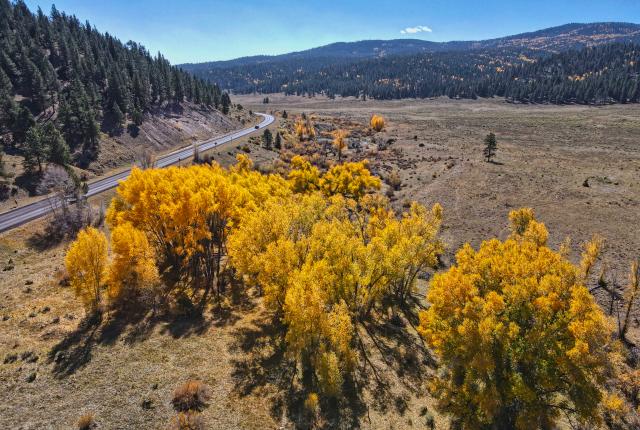MY SON JUMPS THE CREEK, barely a foot wide. He kneels among the brassy, waist-high grasses, gently pushes aside downed aspen, elm, and oak leaves colored in scarlet, coral, and a buttery gold, and peers into the water.
“I see them,” he says with wide-eyed excitement.
My 13-year-old is a water child. He can’t stay away. What he sees in Placer Creek is trout—a fish much larger than you’d think this tiny waterway could support.
While my wife gathers leaves from the surface, my son pulls off his boots and slips into the stream. He gasps as it comes up to his chest. “I can feel them on my ankles,” he says.
In Taos we call it the yellow season. For two to three weeks in late September and early October, aspens dazzle with yellow like honey, chamisa shrubs push out bright golden flowers, grasses dry and turn flaxen, and numerous late-season flowers bloom in various shades of lemon and lavender. The days are warm, the nights cold, the skies a boundless blue.
About 30 miles northwest of our home, the rolling and heavily forested Tusas Mountains spread to the Colorado state line on the north and the Chama Valley to the west. Most of the range lies within the Carson National Forest and sees far fewer visitors than the Sangre de Cristos and the Enchanted Circle, to the north and east of Taos. Huge stands of aspen and Gambel oak, spotted with blue spruces and firs, blanket this remote area.
 A drive through the Tusas Mountains can be just as striking as the Enchanted Circle.
A drive through the Tusas Mountains can be just as striking as the Enchanted Circle.
We park our car just past the turn to Hopewell Lake Campground, where the road crosses Placer Creek. Our family of five knows that you tend to make the best finds when you’re on foot. We follow the creek into a jigsaw landscape of aspens and wide, grassy meadows toward the granitic mass of Jawbone Mountain, about three miles to the northwest. It is a bit hard to tell, but this route is part of the Continental Divide Trail.
The going is easy, the land gentle. We come across the bones of a long-dead coyote, find a large elk antler shed, and watch yellow-rumped warblers pick their way down the creek toward the lake.
My daughter pulls a piece of obsidian from the dirt. Then another. At some point, centuries ago, Native people stopped here, built firepits, and worked the volcanic rock into hunting tools.
There were more occupants here in the past than there are now. After pushing the Indigenous people from this land, colonial settlers—first from Spain and Mexico and later from the United States—planted their roots in these valleys. They brought sheep and cows. They diverted waterways for gardens and livestock. They carved roads. They built homes. Most of them just couldn’t make it. Winters in the Tusas can be brutal, with snows many feet deep.
We leave the trail to explore the nearly invisible ruins of a tiny ranch house hidden in the grasses. We see horseshoes and barbed wire, pliers and rusted-out cans. As with the obsidian, we leave these things be. They belong to the land.
We scramble through stands of red and orange oak and up the rocky edges of Jawbone. To the east, the Sangre de Cristo Mountains spill along the horizon like a fortress wall. North are the mountains of Colorado. Below us, a spiderweb of streams cuts through a sea of yellow.
There are finds to be had on foot and treasures to be had sitting still. From our spot, shaded by an aspen, we watch.
It doesn’t take long. Below and to the east, elk trace the rim of the aspens and spruces. They are vigilant and edgy. We scan the landscape and discover why. Coyotes lope on the opposite side of the valley, crossing the sprawling meadows, poking through late-blooming clusters of purple aster. Then the elk are gone.
Above, turkey vultures soar on thermals. Bald eagles and hawks hunt rabbits and prairie dogs across the fields.
“The Tusas are wild, undeveloped, and incredibly important for an array of wildlife—mule deer, elk, Canada lynx, and more,” says Michael Casaus, New Mexico director of the Wilderness Society. “These mountains provide an important connection between intact habitat in southern Colorado with prime habitat in northern New Mexico.”
After descending Jawbone, my son pours himself into Hopewell Lake, much to the annoyance of some fishermen. I shrug. The kid isn’t quite a solid. “A non-Newtonian fluid,” my daughter calls him.
A flock of blue-winged teals land on the lake. An American coot prowls the grassy banks. Then it is time to go.
Just before sunset, we drive east and out of the Tusas Mountains. The moans of “I’m hungry” blast from the back seat like firecrackers. All the fruit, veggies, snacks, sandwiches, and bars we brought weren’t enough to keep our three active teens satisfied. We pop into a local brewpub. The kids eat and quickly find their friends from school as my wife and I head out onto the patio.
Outside, the seemingly endless sky of northern New Mexico brightens with stars. The Milky Way rises over the mountains. A quality yellow-season weekend draws to an end.

HOPS TO IT
The Taos Mesa Brewing is a great go-to spot after a day in the Tusas Mountains. Since 2012, this brewpub has produced and served some of the finest beer and grub in New Mexico, using local, organic hops (for the craft brews), chicken and beef (for the burgers), and greens (for the salads). The food is straightforward and satisfying. With 16 brews on tap, what to order can get complicated: Scottish Ale, Black Widow Porter, or Amarillo Red? We recommend you opt for the Seco Brut IPA and kick back as a local swing band takes the stage.
201 Paseo del Pueblo Sur, Taos; 575-758-1900


